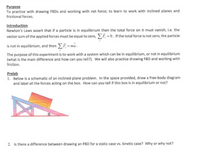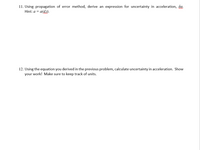
College Physics
11th Edition
ISBN: 9781305952300
Author: Raymond A. Serway, Chris Vuille
Publisher: Cengage Learning
expand_more
expand_more
format_list_bulleted
Question
thumb_up100%
Please if possible do #11-12 with provided work. Thank You!!!

Transcribed Image Text:Purpose
To practice with drawing FBDS and working with net force; to learn to work with inclined planes and
frictional forces.
Introduction
Newton's Laws assert that if a particle is in equilibrium then the total force on it must vanish, i.e. the
vector sum of the applied forces must be equal to zero, F =0. If the total force is not zero, the particle
is not in equilibrium, and then F = ma.
The purpose of this experiment is to work with a system which can be in equilibrium, or not in equilibrium
(what is the main difference and how can you tell?). We will also practice drawing FBD and working with
friction.
Prelab
1. Below is a schematic of an inclined plane problem. In the space provided, draw a free-body diagram
and label all the forces acting on the box. How can you tell if this box is in equilibrium or not?
2. Is there a difference between drawing an FBD for a static case vs. kinetic case? Why or why not?

Transcribed Image Text:11. Using propagation of error method, derive an expression for uncertainty in acceleration, ga.
Hint: a = a(dt).
12. Using the equation you derived in the previous problem, calculate uncertainty in acceleration. Show
your work! Make sure to keep track of units.
Expert Solution
This question has been solved!
Explore an expertly crafted, step-by-step solution for a thorough understanding of key concepts.
This is a popular solution
Trending nowThis is a popular solution!
Step by stepSolved in 2 steps

Knowledge Booster
Similar questions
- answer g onlyarrow_forwardOne vector has magnitude 18 units and another 5.5 units. Find their scalar product if the angle between them is 25 degrees, and then if the angle between them is 82 degrees.arrow_forwardCalculate the dot product: A ∙ B, given that vectors A = 3i + 6j a nd B = 4i – 4j (use - sign in answer, if neededarrow_forward
- Using the definition of the scalar product, find the angle between the following two vectors: A = -2î + 4ĵ , B = 3î – 4ĵ + 2k.arrow_forwardThis is on other question I cannot figure out on the quizlet. Thanks for your helparrow_forwardIf Force = (- 7, 9) and displacement = (-2,-2 ), find the work done from the two vector measurements .arrow_forward
- Given: The energy equivalent of one gallo of gasoline is 1.3 x 10 J. A compact car has a mass of 907 kg, and its efficiency is rated at 16.7%. (That is, 16.7% of the input energy available is delivered to the wheels.) Find the amount of gasoline used to accel- erate the car from rest to 25.1 Answer in units of gal. m/s.arrow_forwardLet a bag of mass 'm' is being raised to a height 'h' from the floor of your classroom. Whatwill be the work done by the applied force (Fa) and gravitational force (Fg)?arrow_forwardThe dot product (3i - j)•B is?arrow_forward
- . Use the definition of scalar product, a two vectors given by a = 5.0 + 5.0 b = ab cos 0, and the fact that a b = axbx + aby + a2b₂ to calculate the angle between the + 5.0k and b = 7.01 +3.0 + 3.0k.arrow_forwardThis is a multiple choice with 3 parts so all parts need to be answered. They are not separate questions so this is not against guidelines. Please just give me the number of the questions and the letter of the answer, no need to do too much work. Thank you!!!arrow_forwardFind the displacement Work done=0.08 J Force=3.221 Narrow_forward
arrow_back_ios
SEE MORE QUESTIONS
arrow_forward_ios
Recommended textbooks for you
 College PhysicsPhysicsISBN:9781305952300Author:Raymond A. Serway, Chris VuillePublisher:Cengage Learning
College PhysicsPhysicsISBN:9781305952300Author:Raymond A. Serway, Chris VuillePublisher:Cengage Learning University Physics (14th Edition)PhysicsISBN:9780133969290Author:Hugh D. Young, Roger A. FreedmanPublisher:PEARSON
University Physics (14th Edition)PhysicsISBN:9780133969290Author:Hugh D. Young, Roger A. FreedmanPublisher:PEARSON Introduction To Quantum MechanicsPhysicsISBN:9781107189638Author:Griffiths, David J., Schroeter, Darrell F.Publisher:Cambridge University Press
Introduction To Quantum MechanicsPhysicsISBN:9781107189638Author:Griffiths, David J., Schroeter, Darrell F.Publisher:Cambridge University Press Physics for Scientists and EngineersPhysicsISBN:9781337553278Author:Raymond A. Serway, John W. JewettPublisher:Cengage Learning
Physics for Scientists and EngineersPhysicsISBN:9781337553278Author:Raymond A. Serway, John W. JewettPublisher:Cengage Learning Lecture- Tutorials for Introductory AstronomyPhysicsISBN:9780321820464Author:Edward E. Prather, Tim P. Slater, Jeff P. Adams, Gina BrissendenPublisher:Addison-Wesley
Lecture- Tutorials for Introductory AstronomyPhysicsISBN:9780321820464Author:Edward E. Prather, Tim P. Slater, Jeff P. Adams, Gina BrissendenPublisher:Addison-Wesley College Physics: A Strategic Approach (4th Editio...PhysicsISBN:9780134609034Author:Randall D. Knight (Professor Emeritus), Brian Jones, Stuart FieldPublisher:PEARSON
College Physics: A Strategic Approach (4th Editio...PhysicsISBN:9780134609034Author:Randall D. Knight (Professor Emeritus), Brian Jones, Stuart FieldPublisher:PEARSON

College Physics
Physics
ISBN:9781305952300
Author:Raymond A. Serway, Chris Vuille
Publisher:Cengage Learning

University Physics (14th Edition)
Physics
ISBN:9780133969290
Author:Hugh D. Young, Roger A. Freedman
Publisher:PEARSON

Introduction To Quantum Mechanics
Physics
ISBN:9781107189638
Author:Griffiths, David J., Schroeter, Darrell F.
Publisher:Cambridge University Press

Physics for Scientists and Engineers
Physics
ISBN:9781337553278
Author:Raymond A. Serway, John W. Jewett
Publisher:Cengage Learning

Lecture- Tutorials for Introductory Astronomy
Physics
ISBN:9780321820464
Author:Edward E. Prather, Tim P. Slater, Jeff P. Adams, Gina Brissenden
Publisher:Addison-Wesley

College Physics: A Strategic Approach (4th Editio...
Physics
ISBN:9780134609034
Author:Randall D. Knight (Professor Emeritus), Brian Jones, Stuart Field
Publisher:PEARSON